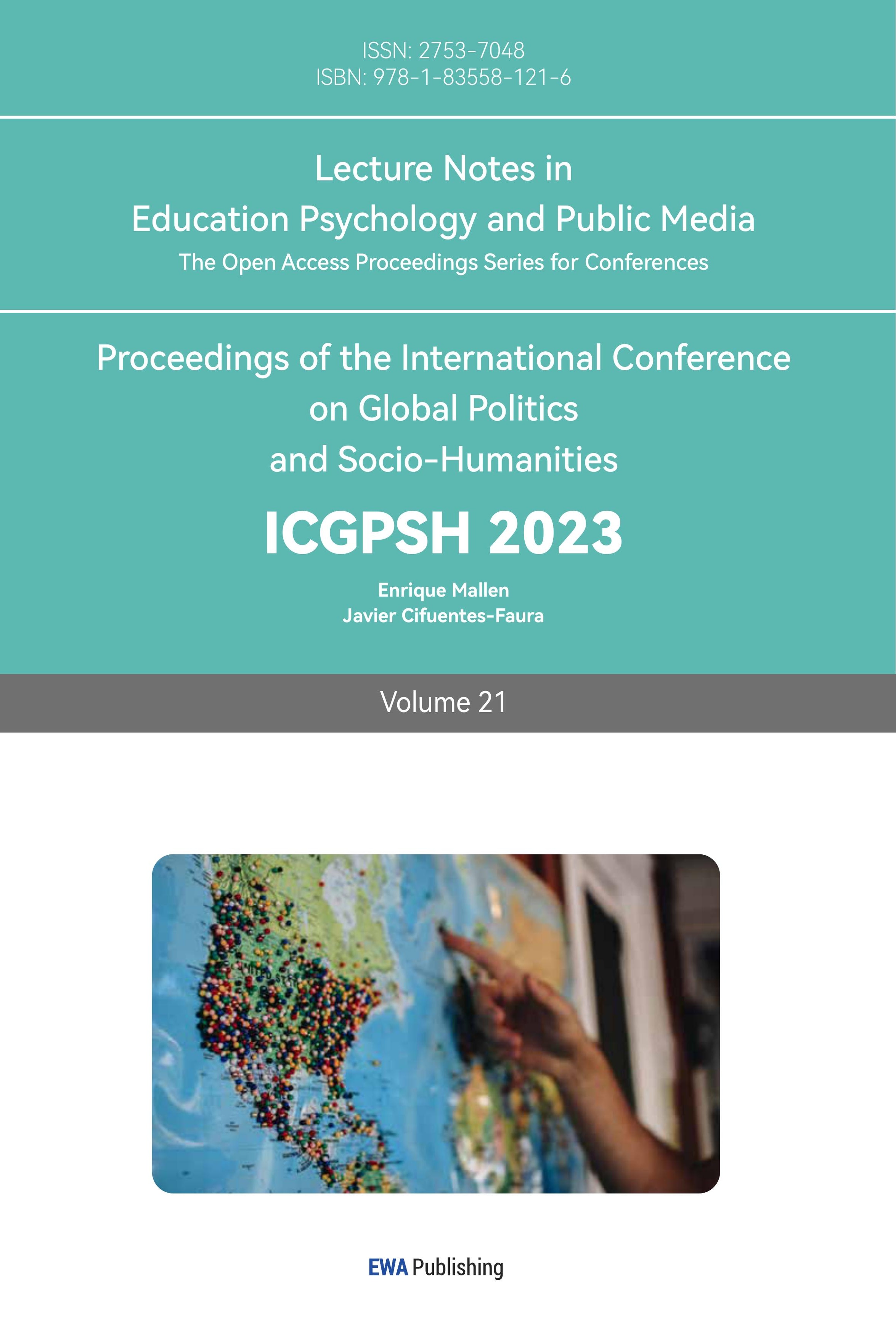References
[1]. Nye, J. (2005) Soft Power: The Way to Success in World Politics. Oriental Publishing House.
[2]. Wang, H.Z. (2016) Symbolic Politics Interpretation of National Image Shaping. Nanjing Social Science, (10), 63-70.
[3]. He, L. (2014) The Role of German Media in Reflecting on Nazi History. Academic Exchange, 248(11), 167-171.
[4]. Yao, H., Zhang, J. (2010) On European Identity and European Integration in Post-Unification Germany. Contemporary World and Socialism, 01.
[5]. Dou, X.W. (2008) Germany’s Experience and Inspiration in Reshaping National Image. Foreign Communication, 147(12), 54-55.
[6]. Ichiro Yoshida. (2007) A Rethink on the Line. Minutes of Niigata University of Business Administration, 3, 145.
[7]. Zhang, G. (1996) Research on Japan’s Foreign Aid Policy. Tianjin People’s Publishing, 205.
[8]. Bi, Y.N. (2019) The Evolution and Construction of Japan’s National Image in the Postwar Period. Journal of Northeast Asia, 01.
[9]. Jin, C.M., Ling, Q. (2014) Japan’s Tourism National Strategy from the Perspective of Cultural Soft Power. World Geography Research, 03.
[10]. Jing, X. (2021) How Germany Repaired Its National Image through Cultural Diplomacy after World War II. Public Diplomacy Quarterly, 03.
[11]. Chen, Z.Q. (2011) Comparison of National Image Building between Japan and Germany. Contemporary World and Socialism, 01.
[12]. Jia, Q.J. (2015) The Ideological Substance of Japan’s ODA Policies towards Southeast Asian Countries during the Cold War Period - Taking Three Representative Japanese Diplomas in Southeast Asia as an Example. Journal of Chongqing University of Technology (Social Sciences), 29(08), 93-97.
Cite this article
Wang,Y. (2023). Comparing the Reconstruction of State Images of Germany and Japan in the Post-World War II Era in the Perspective of Political Symbolism Theory. Lecture Notes in Education Psychology and Public Media,21,314-320.
Data availability
The datasets used and/or analyzed during the current study will be available from the authors upon reasonable request.
Disclaimer/Publisher's Note
The statements, opinions and data contained in all publications are solely those of the individual author(s) and contributor(s) and not of EWA Publishing and/or the editor(s). EWA Publishing and/or the editor(s) disclaim responsibility for any injury to people or property resulting from any ideas, methods, instructions or products referred to in the content.
About volume
Volume title: Proceedings of the International Conference on Global Politics and Socio-Humanities
© 2024 by the author(s). Licensee EWA Publishing, Oxford, UK. This article is an open access article distributed under the terms and
conditions of the Creative Commons Attribution (CC BY) license. Authors who
publish this series agree to the following terms:
1. Authors retain copyright and grant the series right of first publication with the work simultaneously licensed under a Creative Commons
Attribution License that allows others to share the work with an acknowledgment of the work's authorship and initial publication in this
series.
2. Authors are able to enter into separate, additional contractual arrangements for the non-exclusive distribution of the series's published
version of the work (e.g., post it to an institutional repository or publish it in a book), with an acknowledgment of its initial
publication in this series.
3. Authors are permitted and encouraged to post their work online (e.g., in institutional repositories or on their website) prior to and
during the submission process, as it can lead to productive exchanges, as well as earlier and greater citation of published work (See
Open access policy for details).
References
[1]. Nye, J. (2005) Soft Power: The Way to Success in World Politics. Oriental Publishing House.
[2]. Wang, H.Z. (2016) Symbolic Politics Interpretation of National Image Shaping. Nanjing Social Science, (10), 63-70.
[3]. He, L. (2014) The Role of German Media in Reflecting on Nazi History. Academic Exchange, 248(11), 167-171.
[4]. Yao, H., Zhang, J. (2010) On European Identity and European Integration in Post-Unification Germany. Contemporary World and Socialism, 01.
[5]. Dou, X.W. (2008) Germany’s Experience and Inspiration in Reshaping National Image. Foreign Communication, 147(12), 54-55.
[6]. Ichiro Yoshida. (2007) A Rethink on the Line. Minutes of Niigata University of Business Administration, 3, 145.
[7]. Zhang, G. (1996) Research on Japan’s Foreign Aid Policy. Tianjin People’s Publishing, 205.
[8]. Bi, Y.N. (2019) The Evolution and Construction of Japan’s National Image in the Postwar Period. Journal of Northeast Asia, 01.
[9]. Jin, C.M., Ling, Q. (2014) Japan’s Tourism National Strategy from the Perspective of Cultural Soft Power. World Geography Research, 03.
[10]. Jing, X. (2021) How Germany Repaired Its National Image through Cultural Diplomacy after World War II. Public Diplomacy Quarterly, 03.
[11]. Chen, Z.Q. (2011) Comparison of National Image Building between Japan and Germany. Contemporary World and Socialism, 01.
[12]. Jia, Q.J. (2015) The Ideological Substance of Japan’s ODA Policies towards Southeast Asian Countries during the Cold War Period - Taking Three Representative Japanese Diplomas in Southeast Asia as an Example. Journal of Chongqing University of Technology (Social Sciences), 29(08), 93-97.









